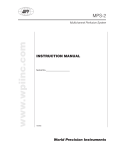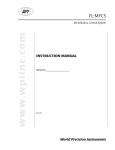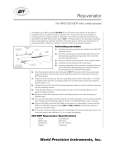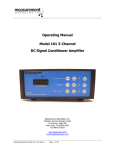Download World Precision Instruments Biological Signals Amplifier Instruction manual
Transcript
Biological Signals Amplifier www.wpiinc.com for isolated heart (Langendorff/Neely) and perfused organ systems INSTRUCTION MANUAL Serial No._____________________ 070212 World Precision Instruments Biological Signals Amplifier CONTENTS ABOUT THIS MANUAL...................................................................................................................... 1 INTRODUCTION .................................................................................................................................. 1 Parts List............................................................................................................................................ 2 Unpacking........................................................................................................................................ 2 INSTRUMENT DESCRIPTION........................................................................................................... 3 Setting Up HG Pressure Amplifiers and Sensors.................................................................. 4 Calibrating the Pressure Sensor to HG Module............................................................. 5 Setting up TH Thermometer Amplifier and Sensor............................................................ 6 Calibrating the Temperature Sensor to the TH Module.............................................. 7 Setting up the ECG Amplifier...................................................................................................... 8 WARRANTY.........................................................................................................................................11 Claims and Returns.....................................................................................................................11 Repairs.............................................................................................................................................11 Copyright © 2012 by World Precision Instruments, Inc. All rights reserved. No part of this publication may be reproduced or translated into any language, in any form, without prior written permission of World Precision Instruments, Inc. World Precision Instruments iii iv World Precision Instruments Biological Signals Amplifier ABOUT THIS MANUAL The following symbols are used in this guide: This symbol indicates a CAUTION. Cautions warn against actions that can cause damage to equipment. Please read these carefully. This symbol indicates a WARNING. Warnings alert you to actions that can cause personal injury or pose a physical threat. Please read these carefully. NOTES and TIPS contain helpful information. Fig. 1—The Biological Signals Amplifier has four modules. INTRODUCTION This amplifier system and the sensors associated with it are designed to detect and amplify perfusate pressures, temperature and ECG signals or surface potentials from isolated perfused heart (Langendorff) and working heart (Neely) preparations. The system can also be used to measure perfusion pressure and temperature from other isolated organs, like kidney, liver and mesentery. In-vivo measurements of blood pressures, temperature and ECG from animals can also be performed using this system. The modules in this amplifier system do not have selectable gain and filter controls, because they are designed to work with data acquisition systems that have circuitry and software for amplifying and filtering recorded data. If you require more information about this amplifier and data recording systems that are capable of working with this amplifier, contact WPI at [email protected] or 941.371.1003. World Precision Instruments 1 The amplifier contains four modules: two for recording fluid pressures (perfusion or aortic, pulse pressure or LVP), one for recording the temperature of the perfusate and tissue, and one for recording ECG signals or surface potentials. The main switch and fuses of the 220/110 V power supplies are located on the back panel of each rack. Input and output sockets are also found on the back panels. Operation switches and indicators are on the front panels. Parts List After unpacking, verify that there is no visible damage to the instrument. Verify that all items are included: (1) Biological Signal Amplifier with: (2) HG AMP-02 pressure amplifiers (1) TH AMP-06 temperature amplifier (1) ECG AMP-03 biopotential signal amplifier (2) Fluid pressure sensors with Canon (D-sub) 9-pin connectors (1) Temperature sensor with microphone jack connector (3) Microphone jack to BNC output cables (1) Power cable (1) Instruction Manual ECG or biopotential electrode and lead cable are not included with this system. Please contact WPI at [email protected] or 941.371.1003 to speak with one of our representatives regarding the type of electrodes needed to record the biopotentials of interest. Unpacking Upon receipt of this instrument, make a thorough inspection of the contents and check for possible damage. Missing cartons or obvious damage to cartons should be noted on the delivery receipt before signing. Concealed damage should be reported at once to the carrier and an inspection requested. Please read the section entitled “Claims and Returns” on page 11 of this manual. Please contact WPI Customer Service if any parts are missing at 941.371.1003 or [email protected]. Returns: Do not return any goods to WPI without obtaining prior approval (RMA # required) and instructions from WPI’s Returns Department. Goods returned (unauthorized) by collect freight may be refused. If a return shipment is necessary, use the original container, if possible. If the original container is not available, use a suitable substitute that is rigid and of adequate size. Wrap the instrument in paper or plastic surrounded with at least 100mm (four inches) of shock absorbing material. For further details, please read the section entitled “Claims and Returns” on page 11 of this manual. 2 World Precision Instruments Biological Signals Amplifier INSTRUMENT DESCRIPTION Fig. 2—The front panel has the operation switches and indicators. Fig. 3—The back panel has the input and output sockets, along with the main power switch. World Precision Instruments 3 Setting Up HG Pressure Amplifiers and Sensors The HG amplifier and its sensor are designed to measure the pressure of the fluid perfusing a heart or an organ (liver, kidney, mesentery), or the aortic pressure developed by the left ventricle of a heart in working mode. The second pressure amplifier and sensor in the system can be used with a catheter to measure diastolic and systolic pressures from the left ventricle of the heart. Fig. 4—(Right) The HG Pressure amplifier, front and back. In addition to in-vitro applications, like perfusion studies, the amplifiers and pressure sensors attached to catheters can be used to make in-vivo measurements of blood pressures from arteries and veins in animals. If a pressure sensor is going to be used: 1. Plug the connector on the end of the perfusion pressure sensor into the IN1 9-pin Canon (D-sub) socket on the back panel of the amplifier. The sensor is now connected to the HG1 amplifier module. 2. Plug the microphone jack of one of the output cables into the OUT1 socket of the HG1 pressure amplifier. Connect the other end of the output cable to one of the analog inputs of the data acquisition unit. 3. Before the transducer is connected to a perfusion cannula or catheter, check the baseline level of the pressure recording channel. Turn the 4-way program switch on the front panel of HG1 amplifier to GND. Turn ON the amplifier. A signal of zero (0) volts is sent by the amplifier to the data recorder. If necessary, set the baseline of the recording channel to zero (0) using the controls of the data recording system. 4. Check the baseline output of the pressure amplifier. Turn the 4-way program switch to MEAS. If the baseline of the pressure recording channel has shifted above or below zero (0), adjust the position of the baseline seen on the recording channel by turning the knob of the BALANCE potentiometer on the front panel of the HG1 amplifier until the baseline is set to zero (0), again. 5. Check the calibration of the pressure sensor and HG1 amplifier at either 10mmHg or 100mmHg. Turn the 4-way program switch to either 10(mmHg) or 100(mmHg) depending on the range of pressures being recorded. The voltage change seen on the pressure recording channel should be 100mVDC for 10mmHg and 1VDC for 100mmHG. 4 World Precision Instruments Biological Signals Amplifier NOTE: If the recorded output signals for the 10mmHg and 100mmHg settings are not 100mVDC and 1VDC respectively, recalibrate the pressure sensor to the HG1 module using the directions provided below. 6. Once the calibration of the sensor and amplifier have been verified, prepare to attach the pressure sensor to the cannula or catheter. Purge all lines to remove any bubbles in the perfusion fluid lines. When ready, adjust the positions of the stopcocks on the sensor lines, and start recording changes in pressure by turning the 4-way program switch on the front of the HG1 module to MEAS. 7. If a second pressure recording is required, connect a second pressure sensor to IN2 input socket of the HG2 amplifier module. Connect the OUT2 output socket of the HG2 module to another analog input on the data recorder using a similar output cable. 8. Check the baselines and calibration of the HG2 amplifier and it sensor using the same procedures used on HG1. Calibrating the Pressure Sensor to HG Module 1. Attach the pressure sensor and the recording system to the HG pressure module as described in the previous section. 2. Turn the 4-way program switch on the front panel of HG amplifier to GND. Set the BALANCE potentiometer to the middle position. Turn on the amplifier. A signal of zero (0) volts is sent by the amplifier to the data recorder. If necessary, set the baseline of the recording channel to zero (0) using the controls of the data recording system. 3. Attach a certified manometer or blood pressure meter to the input port of the pressure sensor. Set the pressure in the manometer or blood pressure meter to zero(0) mm Hg 4. Turn the 4-way program switch to MEAS. If the baseline level on the recording channel changes when this switch is moved from GND to MEAS, adjust the LOW trimmer-potentiometer on the front panel of the module until the baseline on the recording channel is set to zero (00). Remember that the manometer/BP meter has to be set at 0mmHg throughout this step. Return the 4-way program switch to GND before the next step. 5. Set the manometer/BP meter to generate a pressure of 100mmHg. Turn the 4-way program switch to MEAS. The baseline level on the recording channel should read 1VDC for the 100mmHg of pressure. If the value is different, adjust the HIGH potentiometer until the voltage level on the recording channel reads 1VDC. Fig. 5—(Right) The HG pressure sensor. World Precision Instruments 5 Setting up TH Thermometer Amplifier and Sensor The TH amplifier and its sensor are designed to measure the temperature of the fluid perfusing a heart or an organ (liver, kidney, mesentery) in order to determine the temperature of the organ. Fig. 6—The TH Temperature Amplifier, front and back. If the temperature sensor is going to be used: 1. Plug the microphone jack on the end of the temperature sensor to the TH IN socket on the back panel of the amplifier. The sensor is now connected to the TH amplifier module. 2. Plug the microphone jack of one of the output cables into the TH OUT socket of the TH pressure amplifier. Connect the other end of the output cable to one of the analog inputs of the data acquisition unit. 3. Turn the 3-way program switch to GND. Place the temperature probe on or into the area where the temperature needs to be measured. Turn on the amplifier unit. The actual temperature of the area being monitored appears on the 3-digit display on the front panel of the TH module. 4. Check the baseline level of the temperature recording channel. A signal of zero (0) volts is sent by the amplifier to the data recorder. If necessary, set the baseline of the recording channel to zero (0) using the controls of the data recording system. 5. Turn the 3-way program switch to the 45ºC position. The voltage level on the recording channel should change from 0 to 450mVDC corresponding to the programmed 0-45ºC temperature range. 6. Turn the program switch to MEAS. The voltage level on the recording channel should now correspond to the actual temperature at the location of the sensor. 6 World Precision Instruments Biological Signals Amplifier Calibrating the Temperature Sensor to the TH Module 1. In an insulated container, prepare 2–3L of water or fluid at about 20ºC. In a second insulated container prepare 2–3L of water at a higher temperature, about 40ºC. 2. Put a precision thermometer (0.1ºC) through the lid of each insulated container so that the bulb of the thermometer is in the middle of the container. Leave an opening on the lid of each container for the temperature sensor. 3. Place the temperature probe into the cooler fluid. Place the tip of the probe as close to the bulb of the thermometer as possible without touching it. 4. Turn the 3-way program switch to the MEAS position. Wait until the temperature reading on the TH module stabilizes. Then, read the temperature on the thermometer. Set the 3-digit display to the temperature of the thermometer by adjusting the LOW potentiometer on the front of the TH module. 5. Repeat Steps 3 and 4 for the warmer fluid in the other insulated container. Since the temperature of the fluid is warmer, adjust the 3-digit display to read the temperature of the warmer fluid by adjusting the HIGH potentiometer. The TH module and sensor is now set and calibrated for a range of 20–45ºC. Fig. 7—(Right) The TH temperature sensor. World Precision Instruments 7 Setting up the ECG Amplifier The ECG amplifier is designed to record the ECG signals from as many as three different positions (leads I, II, III) on an animal using standard electrodes or surface potentials from the muscle fibers of an isolated heart using wire electrodes. This amplifier is appropriate for use on species in size from rats to dogs. The amplifier also has an internal rate meter which allows the heart rate to be recorded as ECG signals or surface potentials are also recorded. If you are interested in recording ECG signals or other types of biopotentials, contact WPI at [email protected] or 941.371.1003 to speak with one of our representatives regarding the type of electrodes that would be best for recording the biopotentials of interest. The type of electrodes (plate, pellet, needle, wire, etc.) determine the type of lead wires needed to connect the electrodes to the input cable of the ECG amplifier, and the preparation required to attach the electrodes to the animal and promote conduction of the signal. Fig. 8—ECG Amplifier, front and back. If the ECG amplifier is going to be used: 1. Plug the connector on the end of the ECG input cable into the ECG-IN 15-pin Canon (D-sub) socket on the back panel of the amplifier. 2. Plug the connector on the end of the ECG output cable to the ECG-OUT 9-pin Canon (D-sub) socket below the ECG-IN socket. Connect the other ends of the output cable, which are labeled with numbers that correspond to standard ECG limb leads [I (1), II (2), III (3)] to the analog inputs on the data recorder that are needed. 8 TIP: If only one pair of electrodes are needed to record a surface potential from heart muscle, then only one of the leads (I, II, or III) needs to be connected to the data recorder. World Precision Instruments Biological Signals Amplifier 3. Turn the 3-way program switch on the front panel of ECG amplifier to GND. Turn on the amplifier. A signal of zero (0) volts is sent by the amplifier to the data recorder. If necessary, set the baseline of the recording channel to zero (0) using the controls of the data recording system. 4. Check the calibration of the recording channel. Turn the 3-way program switch to 1mV. The signal on the recording channel should show a deflection of 1mVDC, which is the nominal voltage used to calibrate ECG amplifiers. If needed, use the unit conversion function of the data recording program to make the 1mVDC signal from the ECG amplifier create a 1mv deflection on the recording channel. 5. After the calibration check, turn the 3-way program switch to MEAS. Depending on the sets of leads and electrodes that have been attached to the animal or heart, ECG or biopotential signals should appear on the output device. World Precision Instruments 9 10 World Precision Instruments Biological Signals Amplifier WARRANTY WPI (World Precision Instruments, Inc.) warrants to the original purchaser that this equipment, including its components and parts, shall be free from defects in material and workmanship for a period of one year* from the date of receipt. WPI’s obligation under this warranty shall be limited to repair or replacement, at WPI’s option, of the equipment or defective components or parts upon receipt thereof f.o.b. WPI, Sarasota, Florida U.S.A. Return of a repaired instrument shall be f.o.b. Sarasota. The above warranty is contingent upon normal usage and does not cover products which have been modified without WPI’s approval or which have been subjected to unusual physical or electrical stress or on which the original identification marks have been removed or altered. The above warranty will not apply if adjustment, repair or parts replacement is required because of accident, neglect, misuse, failure of electric power, air conditioning, humidity control, or causes other than normal and ordinary usage. To the extent that any of its equipment is furnished by a manufacturer other than WPI, the foregoing warranty shall be applicable only to the extent of the warranty furnished by such other manufacturer. This warranty will not apply to appearance terms, such as knobs, handles, dials or the like. WPI makes no warranty of any kind, express or implied or statutory, including without limitation any warranties of merchantability and/or fitness for a particular purpose. WPI shall not be liable for any damages, whether direct, indirect, special or consequential arising from a failure of this product to operate in the manner desired by the user. WPI shall not be liable for any damage to data or property that may be caused directly or indirectly by use of this product. Claims and Returns Inspect all shipments upon receipt. Missing cartons or obvious damage to cartons should be noted on the delivery receipt before signing. Concealed loss or damage should be reported at once to the carrier and an inspection requested. All claims for shortage or damage must be made within ten (10) days after receipt of shipment. Claims for lost shipments must be made within thirty (30) days of receipt of invoice or other notification of shipment. Please save damaged or pilfered cartons until claim is settled. In some instances, photographic documentation may be required. Some items are time-sensitive; WPI assumes no extended warranty or any liability for use beyond the date specified on the container Do not return any goods to us without obtaining prior approval and instructions from our Returns Department. Goods returned (unauthorized) by collect freight may be refused. Goods accepted for restocking will be exchanged or credited to your WPI account. Goods returned which were ordered by customers in error are subject to a 25% restocking charge. Equipment which was built as a special order cannot be returned. Repairs Contact our Customer Service Department for assistance in the repair of apparatus. Do not return goods until instructions have been received. Returned items must be securely packed to prevent further damage in transit. The Customer is responsible for paying shipping expenses, including adequate insurance on all items returned for repairs. Identification of the item(s) by model number, name, as well as complete description of the difficulties experienced should be written on the repair purchase order and on a tag attached to the item. * Electrodes, batteries and other consumable parts are warranted for 30 days only from the date on which the customer receives these items. World Precision Instruments 11 World Precision Instruments, Inc. USA International Trade Center, 175 Sarasota Center Blvd., Sarasota FL 34240-9258 Tel: 941-371-1003 • Fax: 941-377-5428 • E-mail: [email protected] UK 1 Hunting Gate, Hitchin, Hertfordshire SG4 0TJ Tel: 44 (0)1462 424700 • Fax: 44 (0)1462 424701 • E-mail: [email protected] Germany Zossener Str. 55, 10961 Berlin Tel: 030-6188845 • Fax: 030-6188670 • E-mail: [email protected] China & Hong Kong WPI Shanghai Trading Co., Ltd. Rm 20a, No8 Dong Fang Rd., Lu Jia Zui Financial District, Shanghai PRC Tel: +86 688 85517 • E-mail:[email protected] Internet www.wpiinc.com • store.wpiinc.com • www.wpichemistry.com www.wpi-europe.com • www.wpiinc.cn

























